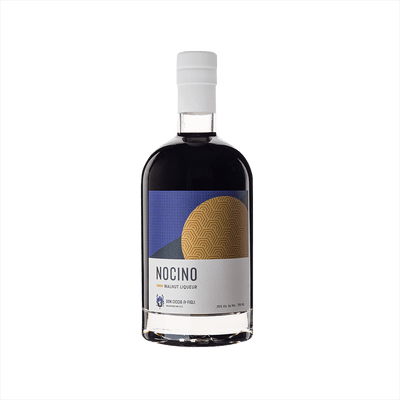Walnut Liqueur
What is Walnut Liqueur?
Walnut liqueur belongs to the broader category of Nut & Seed Liqueurs, representing one of the most distinctive and complex members of this family. These spirits are defined by their deep, earthy richness and the natural oils extracted from walnuts during production, which create a luxurious mouthfeel and intense nutty character. What sets walnut liqueur apart is its ability to balance the natural bitterness of walnut husks with sweetness, often resulting in a dark amber spirit that carries notes of chocolate, coffee, and warm spices.
Learn More About Walnut Liqueur
What makes Walnut Liqueur unique?
Walnut liqueur stands apart from other nut and seed liqueurs through its distinctly earthy, almost woody bitterness that comes from the tannins in walnut hulls and shells. While almond liqueurs lean sweet and marzipan-like, and hazelnut liqueurs offer creamy richness, walnut liqueur delivers a more complex, astringent quality that adds depth rather than simple sweetness to cocktails. This natural bitterness makes it particularly useful as a modifier spirit, capable of adding sophisticated herbal notes that complement aged spirits without overwhelming delicate ingredients.
How is Walnut Liqueur made?
Walnut liqueur starts with fresh green walnuts harvested in early summer before their shells harden, which are then chopped and steeped in neutral spirits or brandy for weeks or months to extract their intense, bitter-sweet flavors. The infusion is typically sweetened with sugar syrup and may include additional spices like cinnamon, cloves, or citrus peel depending on the regional recipe. After aging to allow the flavors to marry and mellow, the liqueur is filtered and bottled, resulting in a dark, aromatic spirit with the distinctive taste of young walnuts and warming spices.
How do you drink Walnut Liqueur?
Walnut liqueur shines brightest when sipped neat as a digestif after dinner, though it's equally delicious on the rocks with a twist of orange peel to open up its nutty complexity. This rich, aromatic spirit finds its way into sophisticated cocktails like variations of the Old Fashioned or Manhattan, where its earthy sweetness plays beautifully with whiskey and bourbon. The cooler months from fall through winter provide the perfect backdrop for walnut liqueur's warming qualities, making it ideal for cozy evenings by the fire or holiday gatherings where its festive, spiced character can truly shine.
How do I choose good Walnut Liqueur?
Look for walnut liqueurs that list real walnuts as a primary ingredient rather than artificial flavoring, and pay attention to the base spirit—brandies tend to offer more complexity while neutral spirits let the walnut shine through cleanly. Your cocktail plans should guide your selection: reach for higher-proof options like Nocino when you need the walnut character to stand up against bold ingredients like whiskey or amaro, but choose gentler, sweeter versions for delicate drinks where you want subtle nutty warmth. Always taste before committing to a full bottle since walnut liqueurs vary wildly in sweetness, intensity, and whether they lean toward fresh green walnut brightness or rich, toasted nuttiness.
Nutritional Information
Typical Calorie Range per Ounce: 80-120 calories
Typical Carbohydrate Range per Ounce: 8-15 grams
Typical Sugar Range per Ounce: 7-14 grams
Typically Gluten Free: Yes
Walnut liqueurs are generally made from walnuts, spirits, and sugar without wheat-based ingredients. The nuts themselves are naturally gluten-free, and most producers use neutral grain spirits that have been distilled to remove gluten proteins. That said, production methods vary between brands, and cross-contamination can occur during manufacturing. Always check the specific product label and manufacturer information to confirm gluten-free status, especially if you have celiac disease or severe gluten sensitivity.
Scrolled this far? Your reward? Walnut Liqueur Trivia!
- The most prized walnut liqueurs are made from "green" walnuts harvested in late June when they're still soft enough to pierce with a needle. These unripe nuts contain higher levels of natural oils and tannins that create the liqueur's distinctive bitter-sweet complexity. Miss this narrow harvest window by even two weeks, and the shells harden too much to extract those precious compounds.
- Traditional Italian nocino makers follow an ancient ritual of harvesting walnuts on the feast day of San Giovanni (June 24th) before sunrise, when the dew is still fresh. Legend says the liqueur gains magical properties when made by barefoot women who climb the trees in their nightgowns – though modern producers have thankfully moved away from this particular requirement while keeping the dawn harvest tradition alive.
- Walnut liqueur naturally turns darker over time due to ongoing chemical reactions between the tannins and alcohol, shifting from amber to deep mahogany over several years. Some vintage bottles of nocino from the 1940s have turned nearly black and are considered liquid gold by collectors, selling for hundreds of dollars despite having no official vintage dating system like wine.
- The distinctive numbing sensation you feel when sipping walnut liqueur comes from juglone, the same natural compound that makes walnut trees "allelopathic" – meaning they can inhibit the growth of other plants around them. This chemical warfare tactic helps walnut trees dominate their territory, and it's what gives the liqueur its characteristic astringent bite that makes your mouth tingle.
- French vin de noix (walnut wine) was once prescribed by doctors as a digestive aid and appetite stimulant, leading to its nickname "the poor man's Armagnac." During World War II, when luxury spirits were scarce, French families would age homemade walnut wine in old cognac barrels, creating surprisingly sophisticated spirits that rivaled expensive brandies at a fraction of the cost.
Higher-proof spirits can be intense. Mix carefully, taste thoughtfully, and enjoy responsibly.
Gift message (optional)


